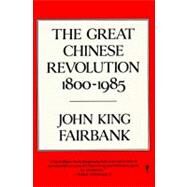The Great Chinese Revolution: 1800-1985
, by Fairbank, John King- ISBN: 9780060390761 | 006039076X
- Cover: Paperback
- Copyright: 1/1/1987
Understanding China's RevolutionFlying into China from Shanghai these days, one can see how close to nature the people live. The whole Yangtze delta, intricately dotted with lakes and crisscrossed by canals, is green cropland. Even its towns and villages are green with trees and household crops, and in place of motor roads the canals are silver thoroughfares of irrigation water. This delta has been the world's biggest food producer for at least seven hundred years. Until a century ago its "tribute rice," towed and poled in narrow barges eleven hundred miles up the Grand Canal, fed Peking. Today it feeds one of the world's most crowded cities, Shanghai.Flying southwest from the gray metropolis one soon crosses hills that have been leveled piecemeal by terracing, so level that water can stand in the rice fields cut into their sides. Here man has rebuilt nature just as permanently as American roadbuilders in the Rockies, but without machines. The terraces are monuments to what muscles can do. The broad lakes south of the Yangtze that fill up every year when it floods are the inland seas that appear in Chinese landscapes. Though remote from the ocean, they make Central China truly a region of "mountains and waters" ("shan-shui," the name for landscape paintings). Cloudbanks and haze make the lakes and mountains seem larger, limitless, and mysterious to the traveler privileged nowadays to see China from the air.If on the other hand you fly northwest from Shanghai toward Peking you are soon traversing the dry North China plain. It is dotted with villages at roughly half-mile intervals much as our Middle Western wheatfields used to be punctuated by family farmsteads, each typicallyconsisting of a white house and big red barn surrounded by a windbreak of trees. China's earth-walled villages also have clumps of trees, at roughly half-mile intervals. But, while the family farmsteads of Iowa and Kansas have







